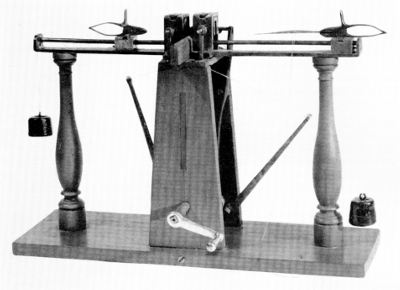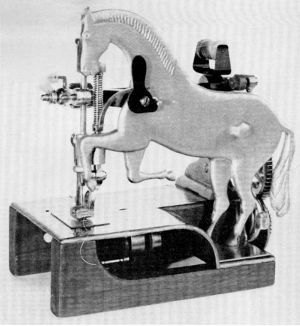
fick John James Greenough patent på sin symaskin det första i U.S.A.
Du kan läsa både om den och andra symaskiner i en rikligt illustrerad skrift hos Gutenberg. "The Invention of the Sewing Machine", by Grace Rogers Cooper.
- Sewing Machine Patent Model
- Patent No. 2,466, issued February 21, 1842
- John James Greenough of Washington, D.C.
- In 1842, John Greenough received the first American patent for a sewing machine. Greenough’s patent model used a needle with two points and an eye in the middle. To make a stitch, the needle would completely pass through the material by means of a pair of pinchers on either side of the seam. The pinchers traveled on a rack and opened and closed automatically. The needle was threaded with a length of thread, and required constant rethreading.
- This type of sewing was classified as a short-thread machine. The machine was designed for sewing leather, and an awl preceded the needle to pierce a hole. The leather was held between clamps on a rack that could be moved, to produce a back stitch, or forward to make a shoemaker’s stitch. The material was fed automatically at a selected rate, according to the length of stitch desired. A weight drew out the thread, and a stop-motion shut down the machinery when a thread broke or became too short. Feed was continuous for the length of the rack-bar, and then it had to be set back. The turn of a crank set all motions to work. Greenough did not commercially manufacture his invention and his patent model remains as the only evidence.
- He held several profitable patents for shoe-pegging machinery. He had many interests and his other patents included ones for plate glass; lampshades; looms; firearms; meters; propellers; gearing; hinges; power-transmitters; car steps; and a paper bag-making machine.
- Greenough worked at the Patent Office from 1837 to 1841, supervising draftsmen who were restoring the patent drawings lost in the disastrous 1836 fire. Later he became an attorney working mostly on patent cases, and established a patent agency in New York City. In 1853, he was one of the founders of the American Polytechnic Journal, which published engravings of recent patents.

Figure 44.—The horse sewing machine is among the most unusual of the patents issued for mechanical improvements. Although James Perry, the patentee, made several claims for the looper, feeder, and tension, he made no mention of the unusual design of the machine, for which a patent was issued on November 23, 1858. Although it was probably one of a kind, the horse machine illustrates the extent to which the inventor’s mind struggled for original design. (Smithsonian photo 45505-C.)


Men åh, så fin, den där hästsymaskinen! Egentligen ligger det ju i symaskinens natur att se ut just så. Vill ha!
SvaraRaderakarin,
RaderaJa, det är nog en av de finaste symaskiner jag sett - ändå finns det gott om vackra maskiner. Jag har en gammal elektrifierad Singer trampmaskin på landet. Vacker och bra.
Du kan kanske såga ut en häst och fästa på din maskin?
Margaretha